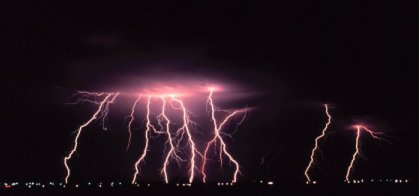

Crash! A lightning bolt illuminates the sky, and the thunder is deafening! The Chihuahuan Desert experiences some spectacular displays from thunderstorms.
Myths abound about thunder and lightning, but what's the reality? It should come as no surprise that it's all about electricity. Electricity results from the movement of electrons, subatomic particles with a negative charge. Opposite charges attract, while like charges repel. Nevertheless, storm turbulence is able to separate positive from negative charges, with the negative electrons going with the heavier, sinking ice particles, while the positive charges are carried upwards. The negatively charged air at the cloud base repels electrons on the ground below, creating a patch of positive charge beneath the cloud. The scene is set for earth and sky to connect!
The lightning strike begins when a channel of electricity builds from
the clouds to the earth. When it connects, there is a powerful surge of electricity up
the channel to the cloud, creating a burst of light! The air around the bolt is heated
explosively, sending out a powerful energy wave that we perceive as thunder.

Listen to the Audio (mp3 format) as recorded by KTEP, Public Radio for the Southwest.
Contributor: Scott Cutler, Centennial Museum, University of Texas at El Paso.
Desert Diary is a joint production of the Centennial Museum and KTEP
Public Radio at the University of Texas at El Paso. ![]()

Time-lapse photography showing numerous strikes over a period of time. Norman, Oklahoma, March, 1978. Photographer, C. Clark. Photograph courtesy of NOAA Photo Library, NOAA Central Library; OAR/ERL/National Severe Storms Laboratory (NSSL).
![]()